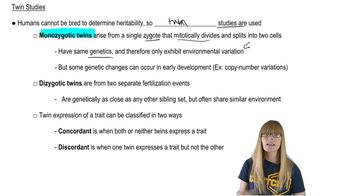Outline the roles played by restriction enzymes and vectors in cloning DNA.
Table of contents
- 1. Introduction to Genetics51m
- 2. Mendel's Laws of Inheritance3h 37m
- 3. Extensions to Mendelian Inheritance2h 41m
- 4. Genetic Mapping and Linkage2h 28m
- 5. Genetics of Bacteria and Viruses1h 21m
- 6. Chromosomal Variation1h 48m
- 7. DNA and Chromosome Structure56m
- 8. DNA Replication1h 10m
- 9. Mitosis and Meiosis1h 34m
- 10. Transcription1h 0m
- 11. Translation58m
- 12. Gene Regulation in Prokaryotes1h 19m
- 13. Gene Regulation in Eukaryotes44m
- 14. Genetic Control of Development44m
- 15. Genomes and Genomics1h 50m
- 16. Transposable Elements47m
- 17. Mutation, Repair, and Recombination1h 6m
- 18. Molecular Genetic Tools19m
- 19. Cancer Genetics29m
- 20. Quantitative Genetics1h 26m
- 21. Population Genetics50m
- 22. Evolutionary Genetics29m
18. Molecular Genetic Tools
Genetic Cloning
Problem 11
Textbook Question
What are some of the impacts of biotechnology on crop plants in the United States?
 Verified step by step guidance
Verified step by step guidance1
Understand that biotechnology in crop plants involves the use of genetic engineering and molecular biology techniques to modify plants for desired traits.
Identify key impacts such as increased crop yields, improved resistance to pests and diseases, and enhanced tolerance to environmental stresses like drought or salinity.
Consider how biotechnology has enabled the development of crops with improved nutritional content, such as biofortified crops with higher vitamin or mineral levels.
Recognize the role of biotechnology in reducing the need for chemical pesticides and herbicides, which can have environmental and economic benefits.
Acknowledge potential concerns and regulatory aspects, including gene flow to wild relatives, development of resistant pests, and public acceptance of genetically modified organisms (GMOs).
 Verified video answer for a similar problem:
Verified video answer for a similar problem:This video solution was recommended by our tutors as helpful for the problem above
Video duration:
25sPlay a video:
Was this helpful?
Key Concepts
Here are the essential concepts you must grasp in order to answer the question correctly.
Genetic Modification
Genetic modification involves altering the DNA of crop plants to introduce desirable traits such as pest resistance, herbicide tolerance, or improved nutritional content. This technology allows for precise changes that can enhance crop yield and reduce reliance on chemical inputs.
Recommended video:
Guided course

Post Translational Modifications
Agricultural Biotechnology Applications
Agricultural biotechnology includes techniques like gene editing, transgenic crops, and marker-assisted selection used to improve crop performance. In the U.S., these applications have led to the development of crops that are more resilient to environmental stresses and have increased productivity.
Recommended video:
Guided course

Modern Genetics
Economic and Environmental Impacts
Biotechnology in crops affects the economy by increasing farmer profits through higher yields and reduced costs. Environmentally, it can decrease pesticide use and soil degradation, but also raises concerns about biodiversity, gene flow to wild relatives, and long-term sustainability.
Recommended video:
Guided course

Twin Studies
Related Videos
Related Practice
Textbook Question
1015
views


